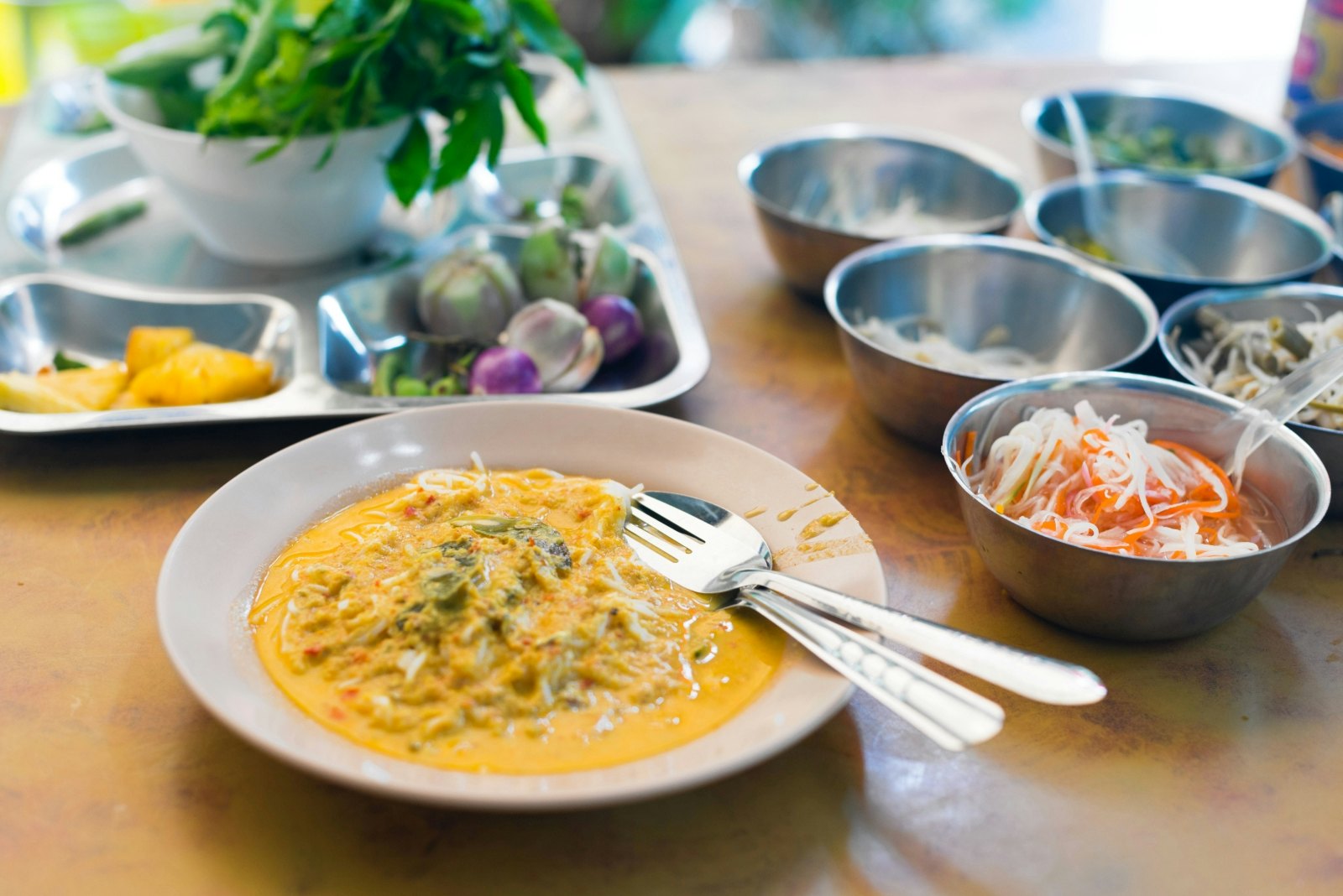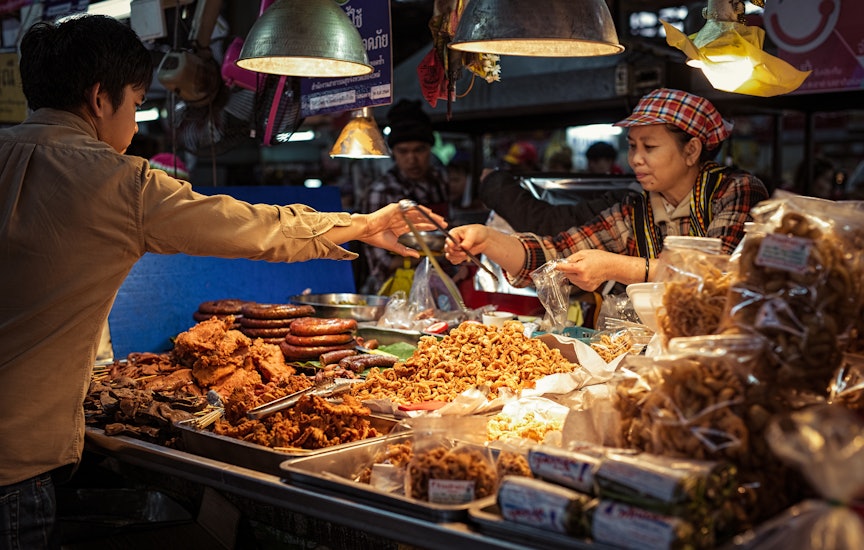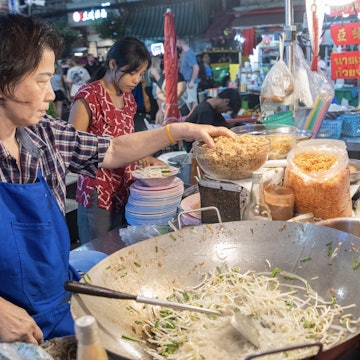

Phuket's restaurants and street food stalls serve cuisine with many influences. Read on for the best dishes and where to try them. Shutterstock
Beyond mild pad Thai rice noodles – or papaya salad for those who can take the heat – Phuket offers an intriguing mix of cuisines, a product of the island’s tin-mining history. The Chinese-Peranakan love flash-fried Hokkien noodles and dim sum. The Muslim population prefers roti, which is sweet or savory pan-fried bread. Those from south Thailand swear by sour fish soups or crispy rice salads packed with spicy flavors. There are also a slew of fiery seafood dishes to try on this profoundly multicultural island.
Whether you prefer lower levels of heat, or you’re a fan of hot sauces, use these pointers on authentic food and drink in Phuket, a UNESCO City of Gastronomy.

Breakfast the local way with kanom jeen kaeng kra-ti
Southeast Asia’s ethnic Mon are said to be the brains behind these thin, cloudy and pearly-white noodles they aptly termed khon om jin, or “cooked and clumped together.” Rather than bog-standard, kanom jeen are rice noodles with a tangy taste, the result of days-long fermentation which makes them highly addictive.
Gathering around long tables, chatting and laughing, families share them topped with luscious curries all over Thailand. Bangkokians call them kanom jeen namya (in this context, it translates as flour-based food with medicinal water) due to the curry’s chilli paste made with herbs and spices like fingerroot, lemongrass, turmeric and galangal, and because they enjoy the rice flour noodles anytime.
Phuketians, though, have a kaeng kra-ti (coconut milk-based curry) version traditionally for breakfast. Sides include crunchy veggies, pickled mustard greens, Thai basil leaves, and dried sardines.
Where to try it: Sansan Kitchen Halal Breakfast, an open-sided restaurant with great service in Thalang district.
Cool off with cha-chak
Cha-chak is Phuket’s answer to the pulled milk tea known as teh tarik in Malaysia. First created there in the 1950s, when workers left without sugar countered plain tea’s bitter tannins with cow milk, pulled tea or cha-chak is a creamy, deep sweet drink with caramel-like notes. Thais concoct it by “pulling” boiled black tea, condensed milk and evaporated creamer between steel mugs until bubbles form a delightfully frothy head.
Unlike Malaysians who slurp it hot, locals in Phuket love that iced, fatty mouthfeel on a hot day. Artisans keep the exact recipe secret, but ingredients likely include black teas like Ceylon or ChaTraMue – tea made from butterfly pea flower, jasmine and Thai green tea leaves. The cherry on top could be star anise, vanilla, cinnamon, orange blossom water or even crushed tamarind, making for a well-rounded drink.
Where to try it: Aroon Po Chana in Phuket Old Town, where you can watch restaurateurs in action.

Dine on dim sum for breakfast – but never alone
Steamed or fried and stuffed with springy, hand-diced pork fillings, shaped into crescent or flower-like dumplings, and originally peddled by yelling waitresses pushing trolleys brimming with bamboo baskets – dim sum highlights all the accoutrements of Chinese cuisine.
Ready-to-eat pork wrapped with quail eggs, bitter melon with a pork filling, or mŏo hoh sarai (pork wrapped with seaweed for a taste of the ocean), each comes with several pieces, so bring travel companions. While humble Chinese roadside eateries abound across Phuket Town, this crowd-pleaser from China has local variations by Phuket’s Muslim population. They’ve given dim sum their own spin by offering translucent, entirely pork-free har gao shrimp dumplings as well as soft seaweed dumplings with chopped carrots and spring onions.
Where to try it: Boonrat Dim Sum and Junhiang Dim Sum are two Hokkien-style restaurants. Must-try halal alternatives include Rafah Dim Sum Halal and Sansan Kitchen Halal Breakfast.

Slurp a bowl of Hokkien noodles
Mee Hokkien are chewy, egg-based noodles traditionally served with pork. The Phuket Babas (the Thai Chinese Peranakan community) have jazzed up the stir-fried dish with readily available seafood like hŏy kratip – briny, soft-fleshed clams with a pleasingly metallic flavor. It goes down well with iced chrysanthemum tea.
Garnished with liquid yolk and dry onions, these yellow, finger-licking good noodles also come with greens, pork slices, fish meat and a black pepper gravy. Try this indulgent blend to experience a mishmash of cultures on this bewitching foodie island, and order mee Hokkien cooked on a charcoal stove if you enjoy a tobacco-like, smoky flavor profile.
Where to try it: Phuket’s first-ever Hokkien noodle restaurant Mee Ton Poe near Phuket’s Surin Circle clock tower, Mee Ko Lan and Mee Sapam are culinary powerhouses.

Gobble up roti and pandan chicken curry
Defying India’s curries, Phuket’s roti pandan chicken curry has a warm, rich flavor profile. Pan-fried flatbread, roti tastes great when crispy outside and soft in the middle. With a curry, locals enjoy this crowd-puller whenever the stomach grumbles. What makes it unique to Phuket is the wonderful addition of fragrant pandan leaves, whose green color adds visual appeal. But the mouth-watering delight doesn’t end here. Seasoned with ginger and sweet, licorice-tasting star anise, the pandan chicken curry has a massaman-like deep flavor, making this kind of roti topped with a fried egg something you'll crave. Roti is also eaten without curry here as a Thai dessert.
Where to try it: Around for 30 years, the roti king of Phuket is Aroon Po Chana, set in a 100-year-old shophouse in the heart of Old Phuket Town. Other places worth checking out include Roti Chaofa Phuket and Chanakorn Bangdet.

Feast on oh aew for mellow afternoons
Calling all sweet tooths frazzled by the heat. Softer than a fairy’s touch, oh aew is a jelly-based treat with a cooling effect. Hokkien-Chinese settlers introduced Aiyu seeds to Phuket. These basil-like seeds, from a variant of the creeping fig, are now making a splash on this sun-kissed island. Mixed with water and mashed bananas, the resulting jelly – sliced into cubes – deftly dovetails the sweetness of sugar corn, watermelon and red bean toppings. The proverbial icing on the cake is shaved ice with a drizzle of Hale’s bright red, palm fruit-flavored syrup. Yum!
Where to try it: One Chun Cafe, a restaurant with Sino-European interiors, and both Raya Restaurant and Tu Kab Khao in century-old Peranakan buildings are some of the best.

Try a sour tŏm som pla soup
Ever munched banana pith? Loaded with fiber and minerals, crunchy banana stems aren’t just highly nutritious; their sweet-tart taste also makes them a beloved ingredient for tŏm som pla, or sour fish soup. Sliced into disc-like pieces and simmered into this wholesome Phuket fish sour soup, their mild aroma with a bitter aftertaste helps achieve the right balance of sweet and sour.
Family recipes are ubiquitous. Besides cashews and sweet and mild grouper, a popular version bursting with flavor includes veggies (galangal, morning glory, banana stalk, onions, lemongrass), fruits (garcinia, pineapple, orange) and condiments like shrimp paste, and – of course – tangy, sun-dried tamarind.
Where to try it: The Charm Dining Gallery

Tickle your tastebuds with mŏo hong
No wonder mŏo hong, or stewed pork belly, has stood the test of time. Brought to Phuket from Southeast China in the 19th century, the island’s signature dish has a delightfully mellow taste. Slow-cooked in soy sauce until it falls off the bone, the tender meat is seasoned with coriander roots, star anise, garlic and black pepper to add warmth and complexity to what would otherwise be a rich, sweet pork dish with dark soy and a drizzle of palm sugar. Pandan and popcorn-scented jasmine rice on your table? Dinner’s ready.
Where to try it: Also at Tu Kab Khao.
Vegetarians and vegans
Your request for vegan or meat-free will rarely fall on deaf ears in Phuket, where Thailand’s annual Vegetarian (technically vegan!) Festival was born. Most restaurants realize the number of vegans and vegetarians is growing worldwide, and the island’s cosmopolitan mix translates into an abundance of vegetarian- and vegan-friendly menus.
Set meals often include tŏm yum (sweet, sour, spicy) vegetable soups or coconut soups with tofu, cashews and leafy greens. Pork, beef, and chicken are common ingredients in Phuket cuisine, but even classics can be adapted to suit a vegetarian palate, such as Hokkien noodles with tofu and veggies. You’ll also find stir-fries, including shitake mushroom-topped pumpkin or glass noodles garnished with Malindjo leaves. Whatever your choice, ensure eateries don’t use oils derived from animal sources like duck fat, lard or tallow.
Where to try it: Many local restaurants on Ranong Rd near Jui Tui Shrine cater to vegetarians and vegans, as do Vegan Phuket, Nong J and The Vegan Table.
Also worth trying in Phuket
Kapek pad goong (stir-fried water bamboo with shrimp): Hard to find, the mildly sweet water bamboo shoots have an asparagus and zucchini-like taste. Try it with shrimp at Raya Restaurant.
Stir-fried beach morning glory bathed in coconut milk: Beach morning glory grows exclusively in Phuket and neighboring Phang-Nga. Chow down on this crispy veggie at Raya Restaurant.
Kanom tao daeng (red tortoise cake): Made with glutinous rice flour and a mung bean coconut milk filling, Thai-Chinese Phuketians serve this auspicious dessert only for special occasions and during Chinese festivals. However you can get these sticky, chewy cakes at Kaset Market daily from 5am to 7am.

A year in food
With relatively hot temperatures throughout the year, many ingredients are available anytime, and if they aren’t, locals get them from other provinces. Still, the rain and heat can influence Phuket dishes, particularly those with fun flavors such as mango.
High season
Mid-December to mid-April
When the Phuket sun beams down relentlessly, other tropical fruits (including mango) are celebrated for their seasonal freshness. The silky-smooth, highly sweet mangoes are an excellent addition to entrees like nose-tingling hot mango salads or desserts like mango sticky rice. Heat-defying veggies, including okra, eggplants and chillies, will spice up your life.
Shoulder season
Mid-April to mid-June and mid-October to mid-December
Especially in June, roadside stalls sell small, incredibly sweet and crunchy Queen pineapples. In the slightly cooler months towards the end of the year, nourishing clear soups are flavored with cabbage, carrots, and broccoli, plus coriander and other herbs.
Low season
Mid-June to mid-October
In the rainy season, squeeze those dark reddish-purple mangosteens and tuck into that white, sweet and juicy flesh hugged by a vampire-red colored wall. The bite-sized, lychee-like longans are just as delicious. Mildly nutty taro and hearty mushrooms add an earthy flavor to vegetarian dishes complete with spices, a sprinkle of dill – and rice that likes the wet season drizzle.
















